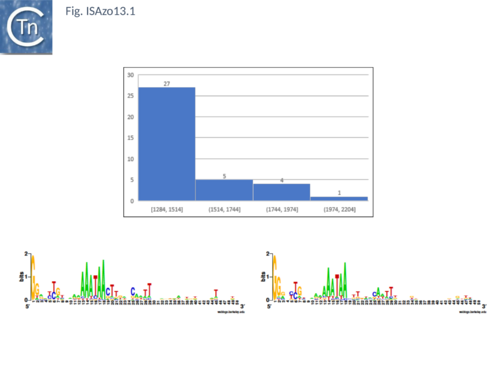Difference between revisions of "IS Families/ISAzo13 family"
Jump to navigation
Jump to search
| Line 1: | Line 1: | ||
'''<big>T</big>'''his family, represented by 37 members in [https://isfinder.biotoul.fr/ ISfinder] emerged from the IS''NCY'' orphan group. It is based on both Tpase and IR sequence similarities [[:File:ISAzo13.1.png|(Fig.ISAzo13)]]. Insertion generates a 3bp AT-rich DR and the ends have a consensus GGa/g. Their Tpases are highly conserved with a probable DDE motif and an HTH motif at the N-terminus which could function as a DNA binding domain. Two members encode two orfs with a possible PRF (programmed transcriptional frameshifting) motif of 8 or 9 A while the other members encode a unique orf which includes a triple lysine at the equivalent position (Gourbeyre, unpublished)<ref><nowiki><pubmed>16381877</pubmed></nowiki></ref>. | '''<big>T</big>'''his family, represented by 37 members in [https://isfinder.biotoul.fr/ ISfinder] emerged from the IS''NCY'' orphan group. It is based on both Tpase and IR sequence similarities [[:File:ISAzo13.1.png|(Fig.ISAzo13)]]. Insertion generates a 3bp AT-rich DR and the ends have a consensus GGa/g. Their Tpases are highly conserved with a probable DDE motif and an HTH motif at the N-terminus which could function as a DNA binding domain. Two members encode two orfs with a possible PRF (programmed transcriptional frameshifting) motif of 8 or 9 A while the other members encode a unique orf which includes a triple lysine at the equivalent position (Gourbeyre, unpublished)<ref><nowiki><pubmed>16381877</pubmed></nowiki></ref>. | ||
| − | [[Image:ISAzo13.1.png|thumb|center|500x500px|'''Fig. ISAzo13.'''|alt=]] | + | [[Image:ISAzo13.1.png|thumb|center|500x500px|'''Fig. ISAzo13.''' General IS''Azo13'' characteristics, average length and common ends.|alt=]] |
==Bibliography== | ==Bibliography== | ||
<references /> | <references /> | ||
Revision as of 14:06, 23 June 2020
This family, represented by 37 members in ISfinder emerged from the ISNCY orphan group. It is based on both Tpase and IR sequence similarities (Fig.ISAzo13). Insertion generates a 3bp AT-rich DR and the ends have a consensus GGa/g. Their Tpases are highly conserved with a probable DDE motif and an HTH motif at the N-terminus which could function as a DNA binding domain. Two members encode two orfs with a possible PRF (programmed transcriptional frameshifting) motif of 8 or 9 A while the other members encode a unique orf which includes a triple lysine at the equivalent position (Gourbeyre, unpublished)[1].
Bibliography
- ↑ <pubmed>16381877</pubmed>
